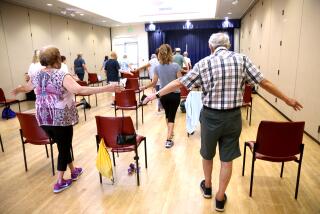Adding Good Years to Our Lives
- Share via
Prolongevity II by Albert Rosenfeld (Knopf: $18.95)
Most people assume that whatever is alive must eventually grow old and die, unless aborted prematurely. Albert Rosenfeld believes that this scenario isn’t preordained, and that increased financial support for research on the aging process could not only increase the human life span and add good life to the extra years (as gerontologists advocate) but also radically improve the quality of human life, psychologically and spiritually.
In 1976, Rosenfeld promulgated his beliefs in a book, “Prolongevity”; in June, 1985, he presented a revised version, “Prolongevity II,” also published by Alfred A. Knopf, with streamlined prose, bigger type, more pages (285 versus 219) and costing $18.95 instead of $8.95.
New research and related comments are reported via footnotes and paragraphs deftly inserted into the original text. Major progress in genetic engineering has caused some changed views: The focus now is on health maintenance rather than the pathology of aging; attention to the cryonics movement (favoring freezing a corpse in anticipation of being able to restore life later on) is minimal this time around.
Rosenfeld still writes cautiously, qualifying one researcher’s excited “Eureka!” by another’s countering “yes, but . . . .” In both books, having duly recorded the evidence for and against a particular theory, he offers his point of view on the subject.
The cast of physicians and scientists is much the same, including names like Alex Comfort, Donner Denckla, Caleb Finch, Leonard Hayflick, Bernard Strehler and Roy Walford. Rosenfeld, although not a scientist, portrays himself as an accepted participant in a network of avant-garde researchers. His chatty, first-person narrative style insufficiently tempers the forbidding scientific content he reports, and gratuitously dropped nicknames and references to social contacts with the quoted experts sometimes strike a jarring note.
Tackling the Questions
First, Rosenfeld talks about the “how” (biological control) and then ponders the “why” of attacking the enemy, senescence. The “how” is a catalogue of questions, research studies, counter-questions and tentative conclusions from his select group of scientists.
Through their work, Rosenfeld concludes that some form of genetic “clock” exists, be it in the basic cellular DNA or in its derivative proteins, and that this clock, once identified, can be adjusted to extend the human life span. He describes exciting laboratory findings on tissue repair, both as it naturally occurs and as enhanced by interventions such as adjustments in nutrition and the use of drugs to strengthen the immune system.
Part II addresses applying these interventions to humans: calorie-restriction, antioxidants, drugs affecting brain deterioration, and life-style/attitude alteration. Some “markers” for aging are known, and testing an individual’s biological age (as opposed to chronological age) can reveal whether specific interventions are effective.
With the caveat that there are no guarantees for its effectiveness, Rosenfeld describes his personal regimen for prolongevity. Like most fitness programs, it comprises “what you eat and drink; what you do to supplement what you eat and drink; what you do with your body; what you do with your mind.”
Do’s and Don’ts
He advocates common sense and self-discipline in diet, with varied content, plenty of water and fiber, restraint in fat, salt, sugar, caffeine and quantity. He lists certain vitamin and mineral supplements, aimed at specific cellular aging factors. His life style eschews smoking and all illicit drugs, tolerates alcohol in moderate amounts, and embraces regular exercise, especially out-of-doors and keeping a “positive, optimistic, interested, engaged outlook on life.”
For what they’re worth as evidence of his program’s effectiveness, his book jacket photos show little change in the author’s appearance between 1976 and 1985.
In Part III, “But Should We Do It?,” Rosenfeld sensitively presents pros and cons of tampering with the human life span. He is pro, not just to indulge the narcissistic individual who is not ready to die, but to free the general human spirit of its endemic, devitalizing fear of death. He ponders the cons, such as disruption of child-rearing practices and inter-generational transfer of economic power, considerations from personal to cosmic, and concludes that, while change is stressful, human life and values have already been drastically changed by scientific advances, continued research is inevitable, and it will solve the problems we anticipate.
The author’s pro-research emphasis is not on immortality, or even prolongevity, but on adding “good years to the human life span.” To enrich the prolonged life, he urges efforts to expand human consciousness, to tap the unrealized capacities of the mind as well as the body.
The prolongevitist hope is that people who live longer will become wiser, able to solve social and political problems that now confound us. Rosenfeld has given a full picture of the prolongevity case to date; the lay reader who may become frustrated over scientific detail in Part I still is likely to find the other sections intriguing and profound. As long as scientists pursue the elixir of life, we can look to Rosenfeld to chronicle their efforts. His next book may take its title from John Donne: “Death, thou shalt die!”
More to Read
Sign up for our Book Club newsletter
Get the latest news, events and more from the Los Angeles Times Book Club, and help us get L.A. reading and talking.
You may occasionally receive promotional content from the Los Angeles Times.










